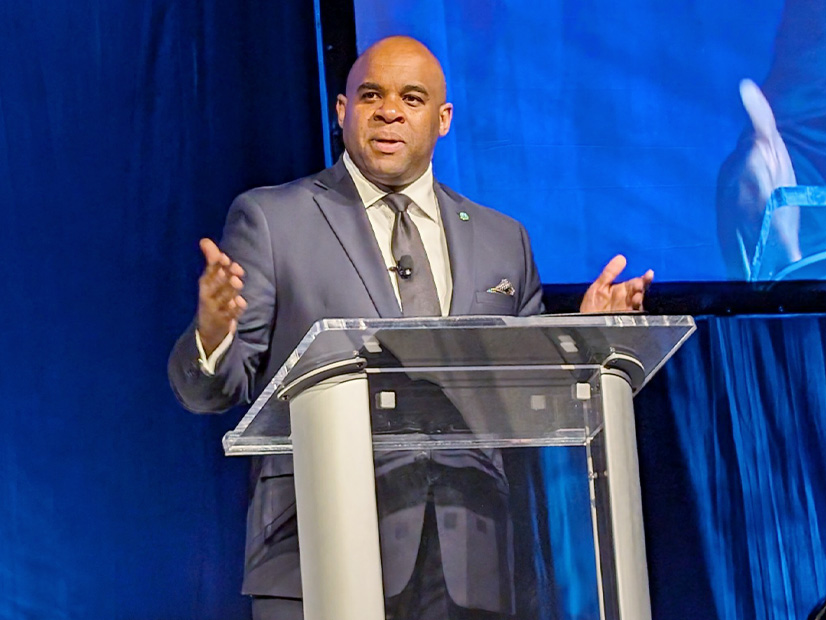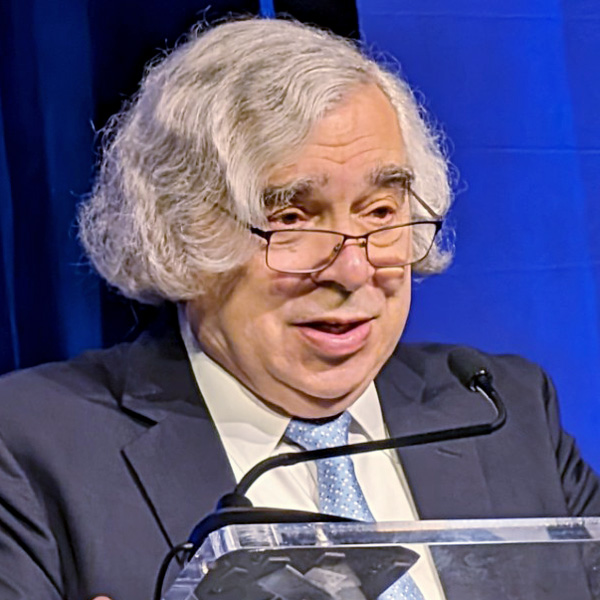
OXON HILL, Md. — FERC Chair Willie Phillips did not expect his audience at the Exelon Innovation Expo to have read every word of the commission’s 1,363-page Order 1920, which sets out to transform transmission planning in the U.S.
But in his June 5 keynote at the daylong event, he did pick out a few key provisions of the order and made a promise.
“State regulators must be and will be at the table when we decide what projects to select and how we will pay for them,” Phillips said, speaking to a packed room of about 1,000 attendees at the MGM National Harbor Hotel & Casino. “And I’ll tell you this right now: If you do not benefit from a project, you will not have to pay for it, period.”
He also stressed the innovative elements of the order’s approach to long-term planning for regional transmission, with a focus on reliability, affordability and sustainability.
“It makes sure that we look out over the long-term, 20-year horizon to make sure that we plan for the reality … on the horizon; that we consider a broad set of benefits when we do this planning, including grid-enhancing technologies,” he said.
Similarly, Phillips described Order 1977, issued with 1920 on May 13, as a “breakthrough when it comes to how we engage with landowners and environmental justice communities” as part of FERC’s backstop permitting authority for projects in federally designated National Interest Electric Transmission Corridors. (See FERC Issues Transmission Rule Without ROFR Changes, Christie’s Vote.)
The order’s Landowner Bill of Rights and requirements for project developers to submit Tribal Resource and Environmental Justice Public Engagement plans are intended to “make sure that these vulnerable communities are a part of planning for the new infrastructure that will power the American economy.”
Speaking on the event’s main theme ― the role of innovation in the U.S. energy transition ― both Phillips and former Energy Secretary Ernest Moniz covered by-now-predictable ground ― the exponential growth in U.S. energy demand driven by data centers and artificial intelligence ― and provided some individual and at times provocative insights.
Now CEO of the nonprofit Energy Futures Initiative, Moniz said current data center load growth signals “we’re just in the early stages of reindustrialization of the United States.”
Phillips agreed, saying “the technology revolution is an energy revolution … pushing the way we consume, the way we produce and the way we distribute our energy across the country.”
Chip, battery and EV factories, and heat pumps are all in the mix, Moniz said, “and then we have wild cards that we still don’t know how they’re going to play out fully.” For example, converting the country’s current hydrogen production from natural gas to green hydrogen produced with electrolyzers could require about one-eighth of total U.S. electricity production, he said.
Moniz agrees with utilities calling for new natural gas generation to meet growing demand.
“I believe that is a reality,” he said. “However, rather than treating this as a conflict, what I think we need to do is to take a more rational view of the clean energy transition. The word ‘transition’ there has meaning; it means we should not be looking at points in time, but a transition.
“We have opportunities to design systems in which, if we have a little more carbon now to meet the load, we have to have a catch-up period during the transition in terms of the overall forcing of global warming. We can do that, but the discussion has to evolve around transition.” Moniz did not elaborate on the impacts of such an approach, such as whether building new gas plants in the near term would increase the likelihood of future stranded assets to be paid for by utility customers, and he was not made available to respond to questions.
However, during his speech, he did say other options for reducing emissions, such as carbon capture and sequestration and advanced or small modular nuclear reactors, “are clearly at least 10 years on the horizon, and that means you don’t wait eight years to start planning it. That means you start last year to start planning it.”
‘Utilities Didn’t Make the Cut’
Phillips also spoke about the connection between innovation and diversity.
“Most successful companies value innovation, and for those companies that value innovation, they also value something else; that’s diversity; diversity of experience and diversity of thought,” he said.
Phillips’ efforts to bring that kind of diverse thinking to FERC are rooted in his own experience, he said, growing up in a single-parent household in Alabama, where he watched his mother spread out bills on the kitchen table to decide which to pay.
“Sometimes, utilities just didn’t make the cut,” he said. “So, it’s never far from my mind, as I do this work, what real, everyday people — ratepayers — what they’re thinking about; what they’re struggling with to make their ends meet,” he said.
Phillips sees the coming spikes in energy demand from a similar perspective. While demand is growing, the fact that “70% of our grid was built in the 1950s and 1960s” translates into an aging system where some regions are facing potential power shortages in the near term, he said. “For regulators like us, [the] question is, what do people do when they don’t have the power they need? What do you do when the lights go out?”
Orders 1920 and 1977 are at least part of the answers to those challenges, he said.
Moniz called Order 1920 the “biggest step by FERC on transmission, probably in more than a decade.” Planning for the clean energy transition, energy security and social equity should be “one conversation in the policy world,” Moniz said. “It may be treated like three conversations, but it’s not. It’s one conversation, and that is the basis of long-term planning.”
But more work needs to be done. Moniz sees demand aggregation and risk sharing as a critical part of long-term planning, pointing to a recent agreement by Google, Microsoft and steel producer Nucor to aggregate their demand and fund clean energy projects that can provide carbon-free power.
“Aggregating demand will again be part of the 20-year planning horizon and a way of sharing risk that the private sector can take on, and the public sector can work with the private sector on,” he said. “There’s no way we can accelerate the way we need to, I think, without all of that.”




My reaction to this headline is: Surely all states benefit from grid projects that make sense. To calculate the benefit, you would need to use the national planning model that determined the welfare maximizing transmission + generation over the next 50 years (making assumptions about how demand and supply evolve over this period and the carbon price). The planning model would then determine the benefit of projects collectively and their costs. One can then determine each state’s net present value of these investments. I conjecture that every state would benefit from the optimal transmission build, making the headline meaningless if efficient transmission is built. Some states will benefit more than others. One could instead have a policy that each state pays in proportion to its benefit.
What will happen will likely be quite different, but it is helpful to think of the first best solution, especially for long-term plans where we can think about what we are doing.